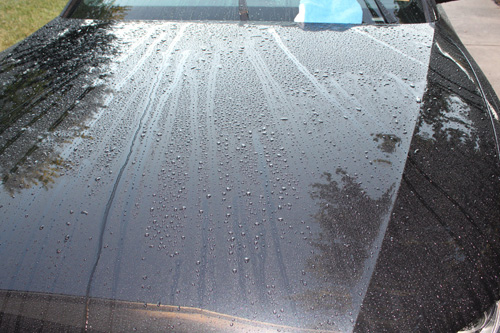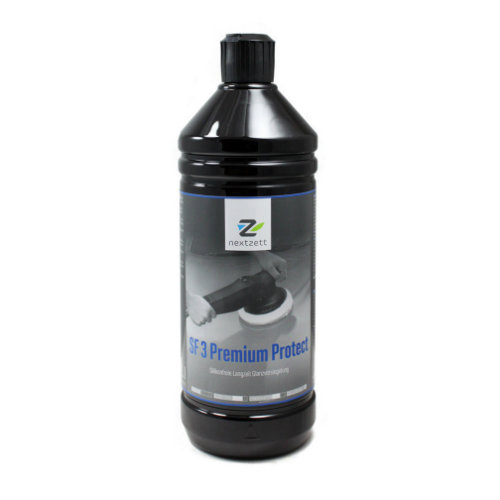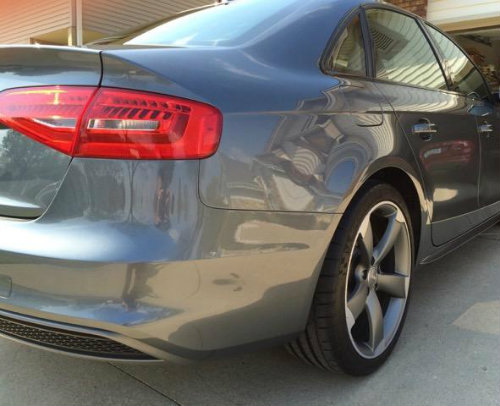By Michael Mankarious
© nextzett USA

Featured Products:
In the article Why Car Polish is Important, part of the "Keep It Clean" series, we looked at car polish and the part it plays in proper paintwork maintenance. Polishing cleans and conditions the paint finish while correcting paint surface issues such as oxidation, light scratches, swirl marks and stains. These all serve to produce a healthier and more visually stunning paint finish.
Now for another important step: protecting this beautiful finish. After all, we don’t want our efforts to go to waste and we certainly don’t want our paint finish to have to look the way it did prior to polishing. To protect the finish, we need to turn to another important part of proper paintwork care: car wax.
When applied, car wax acts as an invisible, yet protective, layer on the paint finish - it's invisible armor for your car. It is like the first line of defense for your paint finish against a variety of environmental elements like acid rain, smog, hard water minerals, UV rays, bird droppings, air born ocean salt, tree sap, dust, brake dust and road grime (to name a few) so that your car's paint finish doesn’t have to. Most importantly, it preserves and protects the results polishing your car provides.
Types of Car Wax
Car Wax has evolved over the decades. Early in the 20th century, there was only one option for car wax: carnauba. Today, we have carnauba, synthetic wax and acrylic.
Carnauba Wax
Carnauba wax is a popular choice of car wax because it's been around the longest and therefore it is the one most people are familiar with. Carnauba wax is the hardest natural wax available and is known for its ease of use and shine. It's derived from the Carnauba Palm located only in northern Brazil. Carnauba wax is also used to coat food, in shoe and floor polish, make-up and dental floss to name just a few.
Carnauba wax can be further refined to remove any additional impurities and colors. This refined carnauba is used by the pharmaceutical industry to coat medicine tablets so they are easier to swallow. This type of carnauba is considered pharmaceutical grade. Some car care product companies claim their waxes have an advantage because they contain pharmaceutical grade carnauba wax. However, there is no difference in protection or shine level compared to regular carnauba wax. There is also no premium carnauba wax. It is all derived from the same source.
In its pure form, carnauba wax is very hard and would be impossible to apply. To make it soft and malleable, so it can be spread on the paint finish, manufacturers mix carnauba wax with other waxes such as bees wax, paraffin wax and polymer waxes. They also combine carnauba with petroleum solvents to soften it.
Even though carnauba may be the hardest natural wax available, it has a more difficult time standing up to the rigors daily driving poses to today's paint finish. Unlike decades ago, today's cars that are driven on a daily basis through urban areas have to deal with a lot more pollution than cars did in the past. Today, acid rain, brake dust, road grime and road salt (for those of you in colder climate regions) and the harsh detergents some carwashes use quickly erode any carnauba wax coating on your car's paint finish. In order to extend their durability, manufacturers mix synthetic polymer waxes in their carnauba wax formulations. The typical carnauba wax can last between one to three months on a daily driver. Driving conditions and other factors can vary this time frame. If you car never sees the light of day except for an occasional car show and rarely gets washed (also known as 'garage queens'), you can expect the wax coating to last a year or more.
Still, carnauba wax remains an ideal way to protect your car's paint finish. Our No. 3 Polish & Wax contains both carnauba wax and polymer waxes and are made to be used on paint finishes that are in new and well-maintained condition. TIP: No. 3 is a go to choice prior to displaying at a car show. As a polish it will clean and condition the paint finish while leaving a layer of carnauba and polymer wax for protection.
Polymer Waxes
The term polymer is a technical term for “synthetic.” Polymer waxes are man-made waxes but are far more durable than natural wax like carnauba – it’s like comparing regular motor oil to synthetic motor oil. Both are the same in principle, but synthetic motor oils are superior because they can withstand higher stresses. The same comparison applies for natural and synthetic-based waxes. Synthetic waxes are much better able to withstand with daily driving, repeated washing and the many environmental stresses such as pollution and acid rain. In general, they can last at least twice as long as a carnauba wax. It is because of this advantage that polymer waxes are mixed with carnauba waxes in carnauba-based waxes.
Keep in mind that polymer waxes are not acrylic sealants which use acrylic resin. Polymer acrylic sealants are also synthetic but are acrylic-based. Sealants create a semi-permanent acrylic coating on the paint finish and like polymer waxes have a high durability. Since the coating is made from acrylic, it has an acrylic shine to it that some people describe as looking like plastic. One major disadvantage of applying acrylic sealants is application time, which can be up to 24 hours. This is why you will not find sealants in professional paint shops or many detail shops. The required time for the product to cure is simply not productive.
Unlike acrylic sealants, polymer waxes imitate the look of real wax. For this reason, many leading European automobile manufacturers specifically recommend the use of either a carnauba or synthetic wax for paintwork protection in their care manuals.
nextzett SF3 Premium Protect is the latest polymer-based wax and can last for several months or at least twice as long as carnauba-based waxes.


Frequency of Application
In general, carnauba-based waxes last approximately one to two months and polymer waxes last at least twice as long. Factors such as environment, weather, driving frequency, washing frequency, washing products, and so on can vary the frequency of required waxing.
The best way to determine whether your paint finish needs wax or not is to look at the water beads on the paint finish washing your car or after it rains. If the water beads are larger than the size of a nickel or larger, it's time to wax. Water beads should be tight and uniform and the water should not sheet off.

Advantages And Disadvantages of Carnauba and Polymer Waxes
Carnauba waxes have reigned supreme for many decades which is why we include it in our No. 3 Polish & Wax formula. As stated earlier, they produce a high gloss, deep finish. However, they tend not to provide long lasting protection. It is easily effected by such elements as washing and high temperatures. For this reason, manufacturers of organic waxes have added polymers in their formula to extend resistance to the elements.
On the other hand, polymer waxes are far more durable and can resist such elements as hard water, heat and even de-icing salt. Unfortunately, polymer waxes have not always produced the deepest shine like organic waxes. Improvements have been made, such as with SF3 Premium Protect, which can produce as much depth and shine as many competing carnauba waxes.
Application
In order to receive the full benefits of waxing, the paint finish should be washed, dried and polished. Do not skip polishing the finish. Besides the wax not adhering completely to the paint finish, you'll be skipping on the most important step. If you are not convinced, please read Why Car Polish is Important. It's possible to never polish the paint yet always wax it and have paint that is brittle and dry. You will also find that the wax doesn't protect as long as it was meant to.
Re-Application: When and How Often?
How often you apply wax is dependent on the type of car wax you use as well as environmental conditions and how often your car’s paint finish is exposed to them. In general, polymer waxes last twice as long as carnauba waxes. While it is suggested that you do not polish the paint finish more than once every few months, there is no harm in waxing too much. A general rule of thumb is this: If you spray the paint finish with water and beads are larger than a nickel, you should apply wax to the finish. Again, how often application is necessary is dependent on the season, how often your car is exposed to the elements (pollution, salt air, sun exposure, hard water, acid rain, etc.), if you have it washed at a car wash, and so on. The more exposed to these different type of factors, the more often you will need to wax. Some areas of the paint finish might benefit from an extra application of wax halfway through the prescribed time period. Such areas might include all top panels (the hood, roof and rear trunk lid), lower valences and front fascia.
Summary
Car wax is the first line of defense for your car's paint finish. After polishing, preserve and protect both your efforts and your paint's finish so that it has years of deep gloss. We hope you now have a better understanding of what car wax is and the role it plays in your overall paintwork care. Waxing, together with polishing, will keep your car’s paint finish looking extraordinary for years to come.
